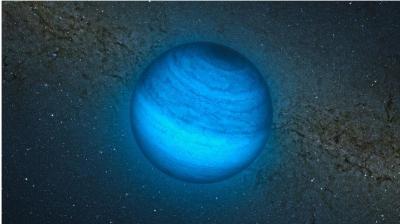Nov 16 2012
A planet that is not orbiting a star, effectively making it homeless, has been discovered by a team of University of Montreal (UdeM) researchers working with European colleagues and data provided by the Canada-France-Hawaii Telescope (CFHT) and the European Southern Observatory's Very Large Telescope (VLT).
 This artist's impression shows the free-floating planet CFBDSIR J214947.2-040308.9. This is the closest such object to the Solar System. Credit: L. Calçada, P. Delorme, Nick Risinger, R. Saito, European Southern Observatory/VVV Consortium
This artist's impression shows the free-floating planet CFBDSIR J214947.2-040308.9. This is the closest such object to the Solar System. Credit: L. Calçada, P. Delorme, Nick Risinger, R. Saito, European Southern Observatory/VVV Consortium
"Although theorists had established the existence of this type of very cold and young planet, one had never been observed until today," said Étienne Artigau, an astrophysicist at UdeM. The absence of a shining star in the vicinity of this planet enabled the team to study its atmosphere in great detail. This information will in turn enable astronomers to better understand exoplanets that do orbit stars.
Free-floating planets are planetary-mass objects that have no gravitational link to a star. "Over the past few years, several objects of this type have been identified, but their existence could not be established without scientific confirmation of their age," explained Jonathan Gagné, a doctoral student of physics at UdeM. "Astronomers weren't sure whether to categorize them as planets or as Brown dwarfs. Brown dwarfs are what we could call failed stars, as they never manage to initiate nuclear reactions in their centres."
Gagné and Artigau, along with Lison Malo and Loïc Albert, all of whom are astrophysicists with UdeM and the Centre for Research in Astrophysics of Quebec (CRAQ), were able to find this planet with the assistance of French astronomers. Philippe Delorme, of the Laboratoire d'Astrophysique de l'Observatoire de Grenoble, was lead researcher. The planet is in fact called CFBDSIR2149 and appears to be part of a group of very young stars known as the AB Doradus Moving Group. "This group is unique in that it is made up of around thirty starts that all have the same age, have the same composition and that move together through space. It's the link between the planet and AB Doradus that enabled us to deduce its age and classify it as a planet," Malo explained.
First of all, the researchers obtained a series of infrared images of CFBDSIR2149 using the 3.6 metres in diameter CFHT. They then used the full strength of the 8 metres in diameter VLT to deduce its mass, its temperature, and of particular note, its age. The planet was found to be between 50 and 120 millions years old, with a temperature of approximately 400 degrees celsius, and a mass four to seven times that of Jupiter. Objects more than 13 times the mass of Jupiter are not considered to be planets but rather Brown dwarfs, as it is this is the minimum amount of mass required for the deuterium at the heart of a star to achieve fusion.
As an aside, it is interesting to note the significance of the finding in terms of the roots of the word "planet." "Planet as a word originates from the Latin word planetus, which originally comes from the Greek words planeta or planêtês, meaning moving or wandering celestial bodies, as opposed to stars which appeared to be in a fixed position in the sky," said Oliver Hernandez, an astrophysicist at UdeM.
In short, this is the first isolated planet – perhaps flung away during its formation – that is not tied by gravity to a star and whose mass, temperature and age meet the relevant criteria. This discovery, which has been sought after for more than a decade, supports theories relating to the formation of stars and planets. Moreover, it supports theories that suggest that these kinds of isolated objects are much more numerous than currently believed.
"This object was discovered during a scan that covered the equivalent of 1000 times the surface of the full moon," Artigau explained. "We observed hundreds of millions of stars and planets, but we only found one homeless planet in our neighbourhood. Now we will be looking for them amongst an astronomical number of sources further afield. It's like looking for a single needle in amongst thousands of haystacks."